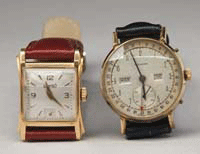|
Still Time To Begin a Wristwatch Collection
By Anne Gilbert
If you can't afford a collection of vintage Rolex's or Patek Philippe
wristwatches, the good news is that many less expensive examples are being
snapped up by collectors. Familiar names are Hamilton, Gruen and Longines, to
mention a few possibilities. Depending on where you find them, prices can be
modest. Those made in the '20s and '30s still turn up at flea markets and garage
sales. They are usually gold-filled, silver or metallic. The wristwatches we
take for granted these days were rejected by men in the early 20th century as
not being masculine.
|

|
Sold as a lot for $575 over an estimate of $100-$200, these two vintage
wristwatches are a Movado (l.) and Eberhard & Co.; 18k, Swiss. (Photo,
courtesy James Julia Auctions, Fairfield, ME.) |
Today's compact, intricate wristwatches are a far cry
from the first wearable time pieces made in the late 15th century. They were
worn like a dagger and hung from a belt. It was in the 17th century that many
new kinds of clockwork movements led to a compact, lightweight watch. At first
these were pocket watches. A later riff was the 19th century railroad watch. It
was at that time that watches began to be especially created for
women.
Though the bracelet watch existed in the late 18th century, it was the
Patek Philippe Co. who began manufacturing bracelet watches in 1868. Around the
same time, they began to be made in Switzerland. However, it was their use in
the 1880s by German naval officers that made them popular. They were discovered
by American soldiers in World War I as a practical alternative to the usual
pocket watch. Shortly, many American companies, such as Elgin, began making
them.
CLUES: For years, the image of quality watches was Swiss, along with
names like Vacheron & Constanin and Baume & Mercier. However, today's
collectors have come to realize that American made watches of the class period
(1900-1950s) by such makers as Hamilton, Longine and Gruen are also of high
quality. Worth looking for are the 1920s Hamilton wristwatches with unusual
design features. These included the Coronado, the Spur and the Piping Rock with
stylized numerals.
By the late 1920s wristwatches had become an important
fashion accessory for both men and women. This included the stylized Art Deco
motifs. They were followed by the Streamline Moderne and Modern designs. Novelty
wristwatches had their beginnings in the 1930s with the reversible wristwatch.
It had a dial that could pivot 180 degrees and could be read with either face
forward. By the 1930s, Disney characters paved the way for the developing market
for novelty watches.
Here are some tips for beginning collectors. Decide on
the type, material and time span. Check out some of the specialized jewelry
auctions and get an idea of prices. Then, go hunting. Even if they don't work,
they can be fixed. Any alteration of the clock face drops the price drastically,
especially with such expensive watches as a Patek Philippe.

|